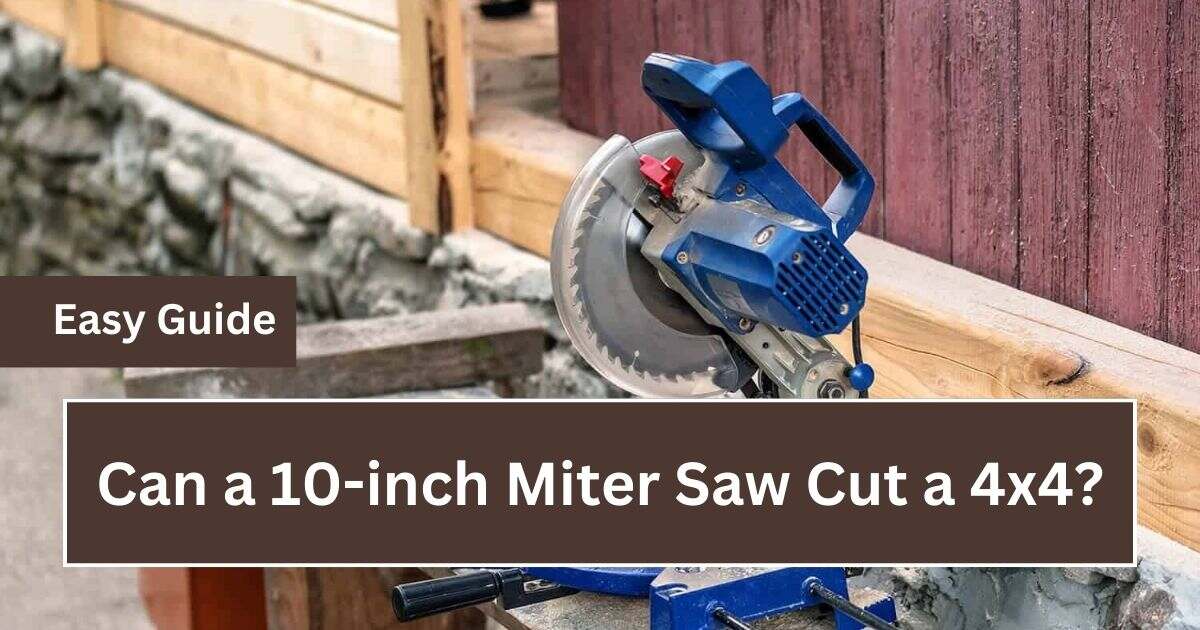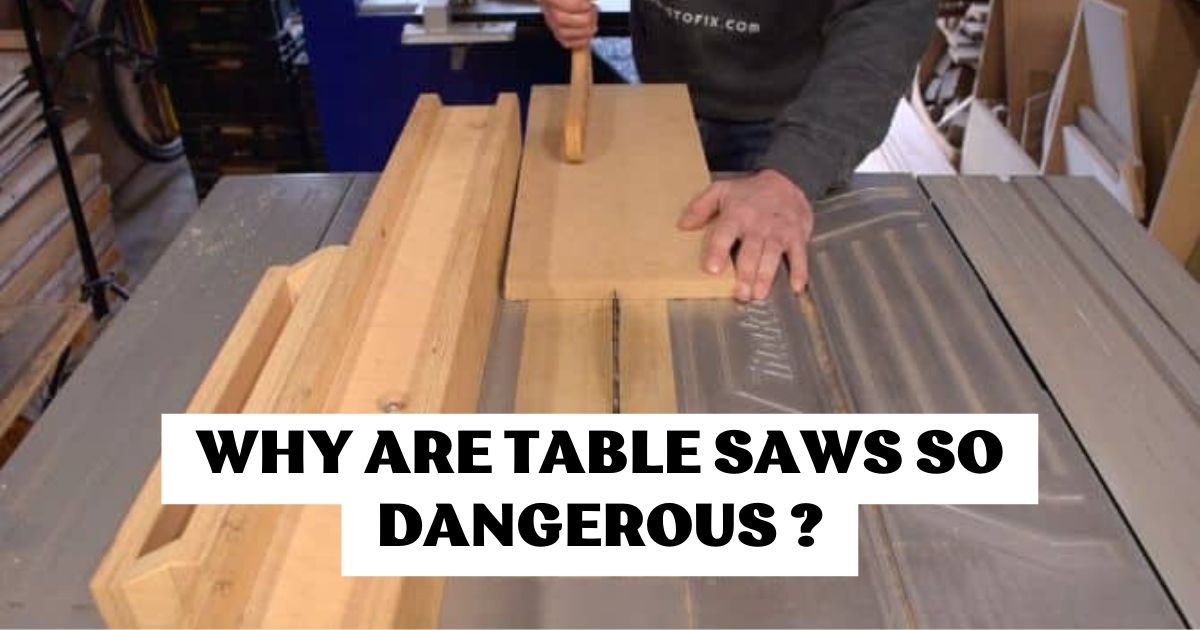You can’t go wrong when using a miter saw to cut baseboard trim. But one question that beginner woodworkers often ask is Can a 10-inch Miter Saw Cut a 4×4?
It’s a good question that has been asked and answered many times, but people still argue about the risks of this game of inches and whether you should put your favorite 10-inch miter saw through it.
When it comes to the difference between cutting 4x4s with a 10-inch miter saw and a 12-inch sliding compound miter saw, there’s not much to unpack. The process is easy to understand, and so is the reason behind it.
Here’s everything you need to know about how this type of saw works, how to handle it, and if you should use a 10-inch miter saw for this type of cut.
Can a 10-inch Miter Saw Cut a 4×4 In a Single Pass?
It’s important to know what a miter saw can do before you order lengths of wood for a DIY project. And when you need to cut 4x4s for your new home DIY project, you’ll want to know right away what your 10′′ miter saw can do.
You might be surprised to learn that the answer to the question of how hard it is to cut 4×4 posts with a miter saw is YES! But there are a couple of things that a 10″ miter saw needs to be able to do before it can do this tricky job.
One way to cut a 44 in a single pass is to change the blade guard so that the saw can cut through more material. If you can give the blade more room, even a 10-inch blade should be able to cut cleanly through a 4×4 post in a single pass.
If you can’t adjust your blade guard (and you should be very careful if you do), the only way to make the cut all at once is to use a sliding dual bevel miter saw.
Because the head of a sliding miter saw can be tilted forward, it has a wider range of motion. This obviously moves the blade forward and makes the miter saw better at cutting.
Major Drawbacks Of Cutting 4×4 With a 10″ Miter Saw:
There are numerous disadvantages to utilizing a 10-inch miter saw to cut 44 posts or things of comparable size. The greater time necessary to finish the operation when compared to utilizing a 12-inch miter saw is perhaps the most noticeable disadvantage.
The difference in cutting time between 10″ and 12″ miter saws is substantial. The additional 2 inches offered by a 12″ miter saw is often provided by more expensive sliding dual bevel compound miter saw models with better cutting capacity, adaptability, and power & torque than 10″ miter saws.
Consider also the additional blade maintenance that is required. Ten-inch blades perform poorly on four-wheel-drive vehicles. They dull far more quickly, and you will eventually be unable to sharpen them sufficiently to make quality cuts in the future.
Theoretically, you may believe that using a 10″ miter saw to cut 4x4s is the cheaper alternative, but in practice, the situation is entirely different. Using a 12″ miter saw will save you money in the long term, even though the initial cost of a sliding dual bevel compound miter saw is more.
Blades, electricity, and all other connected expenses will quickly add up.
Miter saws are generally safe to operate. Nonetheless, kickbacks may occur if the incorrect material is cut with the saw. When using a 10″ miter saw to cut through thick and brittle 4x4s, kickbacks are likely to occur.
Last but not least, a lack of torque and persistently exceeding the 10″ miter saw’s capacity might cause engine damage and overheating.
The situation is comparable when attempting to cut metal with a miter saw. Even if both tasks can be completed successfully (with minimal modifications), you must take additional measures.
Also, keep in mind that doing such demanding tasks with your miter saw may exceed the saw’s capabilities, and any resulting damage may not be covered by the guarantee.
What Is Better About The 12″ Miter Saw?
If you want to reliably cut 4x4s and plan to use them in many projects in the future, you’re asking the wrong question. It shouldn’t matter if a 10-inch miter saw can cut a 4×4 or not. What should matter is what miter saw is better for cutting 4x4s.
The short answer is that you need a miter saw that is 12 inches long. And this is something you should think about when deciding whether to buy a single-bevel or a dual-bevel miter saw.
Both of these types of saws can cut different things, which will be a big factor, but the price will probably also be a factor. A sliding 12″ miter saw costs a lot.
It’s clear that the blade on a 12″ miter saw is bigger. This means that it can cut wider and longer pieces faster. The cutting capacity is so much better than even the cheapest 12″ miter saws on the market will still cut through 4x4s faster and cleaner than the best 10″ sliding miter saw.
The 12″ blade will make smooth cuts because the teeth are sharper and the TPI is a little bit higher. The miter saw is also less likely to kick back, which makes it much safer to use.
What Can You Cut With a 10″ Miter Saw?
So, can a 10-inch miter saw cut through a 44? The clear answer is yes. But because of the extra inches, you shouldn’t try to make this kind of cut with a 10″ blade because of the risk/reward ratio. Still, there is some good news.
Even though a 10″ miter saw isn’t the best way to cut 4x4s, that doesn’t mean it isn’t a useful tool to have in your workshop. In fact, the 10″ miter saw is easier to move than the 12″ miter saw.
Most small home repair jobs can be done with a 10-inch miter saw. They are easier to use and lighter than a 12-inch miter saw. They also use less power and can be helpful if you have a small shop with limited space.
How Does This Affect The Average Homeowner?
There is little to no reason, unless you are a skilled carpenter, to own both types of miter saws. If your daily duties do not regularly include cutting through 4x4s, then the 12″ miter saw is a tool you will rarely require.
A 10″ miter saw can be used for the majority of art projects, repair jobs, do-it-yourself furniture chores, and other projects, such as cutting tile, pipes, PVC, etc.
Here’s How to Cut a 4×4 If You Have To.
Assuming you have to cut some 4×4 studs and can’t use anything but your 10″ miter saw, it’s best to know how to do it right so you don’t put too much stress on the tool and its blade.
It’s just as important to get ready as it is to actually make the cut. You need to do four things. Even though it’s not hard to understand, the rules below are very important.
Marking The Stock:
Get your pencil and a square so you can measure the right things. Draw a clear line or mark on the 4×4 to make sure the cut is done with some accuracy. Make sure that the 4×4 is marked on all four sides.
Configuring The Saw:
After you’ve marked the stock, you’ll need to set up or prepare the miter saw. Fix it to the workbench. Since the motor will be pushed to its limits and past, it will need to be more stable than usual.
Adjust the angle of the blade so that it falls straight down on the stock at a 90-degree angle. Always use a square to check the angle again. Do this to make sure that the miter saw is set up correctly and that the cut will be straight when you use it.
Positioning The 4×4:
Put the stock on the workbench and move the marked area under the blade. If you don’t have to make a lot of cuts, you can attach the 4×4 to your workbench to stop it from kicking back.
How To Cut 4x4s The Right Way:
When it comes to cutting the stock, things get tricky. This is true whether you are using a table saw or a miter saw to make the cut. But if you want to use a 10″ miter saw to make this cut, here’s how to do it safely.
- Start your saw with the head in the resting position, which is straight up. Slowly move it towards the mark while pressing down hard on the side of the 4×4 to make it more stable.
- By slowly pushing the blade into the wood, you lessen the chance that it will kick back at you. After you’ve made your cut on the first side, bring the blade back up and stop the saw. Turn the stock over to see another marked area, and then cut again.
Cutting a 4×4 with a 10″ miter saw can take a long time for two reasons. First, the saw doesn’t have enough torque to cut through such thick pieces of wood. Second, you have to cut from all four sides to make a cut that is mostly smooth, clean, and accurate.
People often make one of the biggest mistakes by adjusting the blade guard so that they can push the blade through in one or two passes. It might be faster, but it’s not a good idea if you want clean cuts and don’t want to damage the miter saw.
By making multiple cuts that meet in the middle of the 4×4, you don’t put too much stress on the miter saw and the blade.
Even though it looks easy on paper, this won’t be easy the first couple of times. With a 10-inch miter saw, it’s easier to cut 4x4s than it is to cut trim because trim can be cut in a single pass with a miter saw.
To get clean cuts on all four sides, you will need to practice. It will also depend on how your saw is made and how the blade guard is put together.
Bottom Line:
Now that you know you can cut a 4×4 with a 10-inch miter saw, would you still be brave enough to try it? Even if you use the recommended method I already explained, it’s a hard cut.
It also takes a lot of time, and if you just use the right size miter saw to make this cut, it could be much better for the life of your miter saw. Why? Because using this kind of cut too often will eventually damage the motor and dull the blades.
Still, you don’t want to buy and change miter saw blades very often. It costs more and more.
But if you have a high-quality sliding dual bevel compound miter saw, your life will be much easier because it will have more power and be able to cut through more materials.
FAQ’s
What is the Best Saw to Cut 4×4?
A regular jigsaw won’t have enough depth to cut through a 4×4 post, and trying to do so would be dangerous. A saw with a long blade that moves back and forth would be a better choice.
What Blade is Best for Ripping 4×4?
The best saw blade for ripping hardwood is a rip blade. This blade is specially made for cutting through wood fibers, so it will cut through hardwood easily and leave a clean edge. Rip blades usually have 10 to 40 flat-topped (FT) teeth, which is a comparatively small number, but it will move through the grain quickly.
Meta Description:






